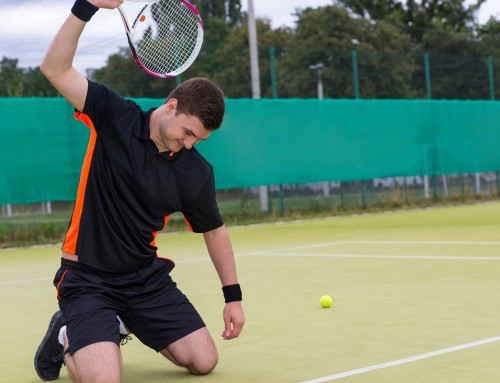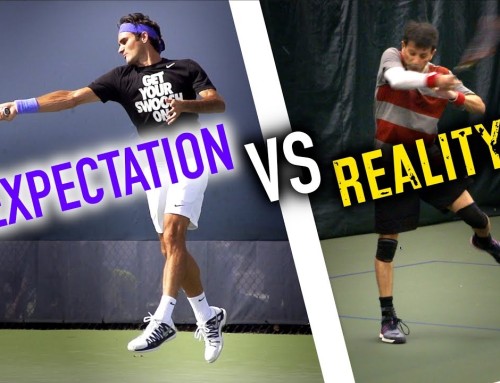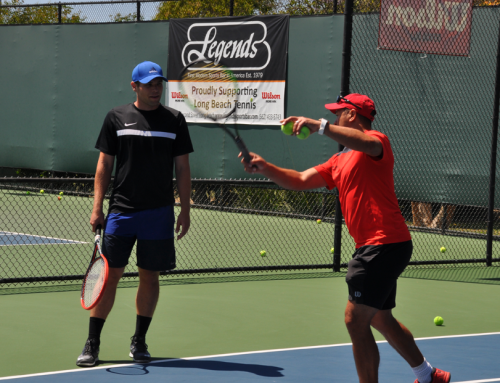Brent Abel runs the excellent tennis instruction website www.webtennis.com. In this week’s episode of the podcast he’s my guest as we discuss several topics that are vital to the improvement of tennis players everywhere: singles strategy, doubles strategy, trying to copy the pros, and what to do when you find yourself stuck in a rut with your tennis game. Brent has some great insights that I know you’ll find helpful!
Download Transcript: Word Doc | PDF | Kindle | Text
Welcome to the Essential Tennis podcast. If you love tennis and want to improve your game, this podcast is for you. Whether it’s technique, strategy, equipment, or the mental game, tennis professional Ian Westermann is here to make you a better player. And now, here’s Ian.
Ian Westermann: Hi and welcome to the Essential Tennis podcast, your place for free expert’s tennis instruction that can truly help you improve your game. Today’s episode of the podcast is brought to you by Tennis Express. Please check them out this week by going to EssentialTennis.com/Express.
I’ve got a great interview with Brent Abel. I’m going to talk to him about getting better at tennis, about tennis technique, both singles and doubles, and about getting better when you’re in a rut. Brent has great insights.
Real quickly, I’ve been exchanging emails back and forth from the people over at Tennis Round.com. I just wanted to tell you about this site. It’s a place where you can find tennis partners and tennis courts in your local area, which I think is a great idea. You can sign up for free, tell people what level you are, and also search for other courts and players in your area. They have players registered in over 600 US cities. So much of the instruction I give are things you should be doing cooperatively, and this is a great way to find players who are online, their tech savvy, and they’re really taking the game seriously. Again that’s tennisround.com, and it’s totally free. With that let’s get to today’s interview, sit back, relax, and get ready for some great tennis instruction.
My guest today is Brent Abel. He runs webtennis.com which I’m sure many of you are already familiar with. Thank you for taking a time out and talking to us. It’s great to have you on the show.
Brent Abel: Thanks Ian. Appreciate you inviting me on and looking forward to talking with you today.
Ian Westermann: For those of my listeners who aren’t familiar with you and your website, can you please talk to us a little bit about your experiences as both a tennis and as a player? And we’ll talk about the website after that.
Brent Abel: Yeah. I’ve been playing tennis for a long, long time. I learned how to play when I was a young kid and started tennis when I was pretty young. I was in my early 20s and really taught at a number of different facilities around the country. Little bit of teaching in Europe for a summer. Where I really got organized as a teaching pro was when I worked with Tom Stow who is a legendary coach here in Northern California. That was back in the early 80s, and he really transformed my game from the older cliches, which weren’t really very perspective to much more of a style that was more of a system. It was focused on the fundamentals, and there’s really where my teaching is based on.
Then as a player I’ve played a lot of senior tennis and won a number of senior titles. So I keep playing a lot. I love to compete, and I love to teach. So it’s been a long teaching career, 35+ years. And enjoying it more than ever.
Ian Westermann: I just have to say – this is something that I’m looking for when I look at a tennis teacher, and something really important to me is seeing if they play themselves and have a passion for the game. You know very well that it’s rare to see somebody who teaches full-time and actually plays themselves. And so I’m really impressed that throughout your teaching career and still now at an age where many complain and play less, it sounds like you’re playing more than ever and that’s very impressive.
Brent Abel: I appreciate that. One thing that really helped me play more is now with the internet I can do all of my teaching online, which before I was out on the court 30-40 hours a week, and really it’s manual labor. It’s tough on the body. I do agree with you. I’m getting as much enjoyment as I ever have before. So much of that is what can I really do to strip away stuff that I really get to focus on the fundamentals.
Ian Westermann: Yeah. Lets talk about your website because I want to make sure that all of my listeners go and check it out. When did you transition to being more of an online teacher? Tell us a little about the website in general.
Brent Abel: I got webtennis.com going back in 1999 because I knew I wasn’t going to be able to physically teach tennis my whole life, and I just sort of hoped and felt that this might be an opportunity. Back then there wasn’t really any blueprint to work from on how to build a simple website, blogs, how to market stuff, and so in 2005 I’ve been at the California tennis clubs and been their director for some time, so I had enough money to where I could devote full-time to really develop this business online. October 2005 I took the big gulp and resigned from there. Been going full-time ever since then. As you know Ian, it’s a very fun way to teach. Very rewarding. Now I’ve got students globally instead of students at one club.
Ian Westermann: Awesome. I urge everybody to check out Brent’s website. Lots of solid instruction. Let’s get to some instructional topics. I’ve got a list of them there. They vary in category from technique to singles strategy, doubles strategy. I’m not sure how much time we’ll have to get to all of them, but I tried to pick out some questions that were good topics. Question number one I have has to do with the internet and how more and more players are figuring out that you can find a lot of instruction online. Things are just starting to get going online. What do you think is the most commonly misunderstood element of tennis online?
Brent Abel: In one word I think it’s topspin, and I think there’s a real overemphasis on topspin. I mean, it’s not the fault of the players. I think it’s more the fault of the pros. It’s just unrealistic that you can base your game on just big kind of topspin extreme foregrips and think that you can grip and rip all day. Again it’s easy to look at the pros with all the technology we’ve got now. Really my job and your job is really what can we do to help students play for the rest of their lives.
Ian Westermann: With all the crazy stuff that pros are doing these days and our modern technology – are there things that my listeners, your typical player, can learn from the pros? If so can you give us an example of what we should look for?
Brent Abel: Yeah, I think one of the things we can really look at is just the consistency that they have with their spacing. And I mean their spatial distance from the incoming path of the ball. They are so consistent with it that these guys make the swing look so easy. The reason is because the ball is always exactly where they want it to be. Rec players, they mostly crowd the ball.
So my advice always is to work on your spacing, and once you find out what is your ideal point of contact, well then all you have to do is just absolutely work your feet so that you get yourself a net position. You’re always in that good hitting position.
Ian Westermann: Great. Let’s shift gears a little bit and talk about tactics a little bit. Let’s start off with singles strategy. If you have to pick one point across to a recreational player that you think is the most important thing to understand about singles strategy, what would that be?
Brent Abel: The game needs to be played on a more vertical strategy as opposed to a horizontal. A horizontal is where we think we’re going to move our opponent from side to side, and too often what happens is I see a lot of good shots get played to a corner or out wide, and you get your opponent stretched out wide and you don’t move forward in anticipation in a short ball that you can volley as a transitional shot to the open court. So what I like to teach is the value of vertical attack, meaning that if you’ve got someone who can run all day long, you’ve really got to be able to draw them into the net and then either you go for the pass or go for the lob over the back hand. I think at the rec level the one shot that the players don’t work on enough is they do produce a lot of short balls and rather than always playing an approach shot, I really encourage them to work on what looks like an approach and then you play a drop shot. I want my students sort of always making their opponents that there’s always a chance that you’re going to have to move up. And once you get them anticipating that, then I think the side to side starts to work a bit better.
Ian Westermann: I totally agree with you that rec players tend to really over focus on the horizontal aspect. What is it? Is it just a visual thing that for whatever reason that seems to be so obvious to beginner players? And they don’t even think that the ball might be coming back short? What is it about that horizontal and vertical game?
Brent Abel: I think a lot of it is not playing shots in no man’s land. That area inside the baseline and probably right around the service line. So I think players get intimidated about having to place shots in there, so whether that’s instinctive, whatever it is, you have to de-sensitize the student and say we’re just going to practice this thing until you’re comfortable with it. A lot of it is not recognizing that you’re going to get a short ball, and for me I’d rather get a transitional volley than have to get a short ball where that short ball lands about 3 feet and just sits there. So I don’t mind playing that transitional volley when I get a lot of pace because I know I’ve got the ball. I’ve got something I can just redirect and because there’s so much pace coming in, that opponent is hung out to dry. So I’ve got a bigger court to hit into.
Ian Westermann: That’s a really great transition into doubles. That’s why I wanted to ask you about next as far as transitional volleys and half volleys are concerned. So if you had to give one point across to rec players about doubles what would that be?
Brent Abel: I think learning how to play the transitional shot and not fearing no man’s land is really the shot that is going to make you or break you as a good player in doubles. Learning how to play the cross-court half volley, the cross-court transitional half-volley or volley from no man’s land, which is — it’s just not realistic to think that you can serve and get up inside the service line or that you can chip and charge a return of service and not have to play a ball inside that no man’s land area. So again it’s like anything else in tennis. You might be fearful of it in the beginning, but the more you practice it the more you desensitize yourself to that fear. And the more you start believing that what I can play this shot and by playing it you really end up putting you and your partner in a good net position. And then as both players get up closer to the net, they will start winning more points.
Ian Westermann: Absolutely. That’s really kind of the whole doubles domination course is helping to gear players to understand that really is true because so many are incredibly skeptical of having both players up at the net. They’ve had poor experiences getting lobbed and not having good effective volleys and not being confident with their overheads. And that’s kind of my quest is getting rec players comfortable in that formation. I agree with you that’s by far the most advantageous position.
Brent Abel: It just takes practice. The guys who put in the more practice time are the ones who progress the quickest. No one has the magic bullet. The student has to put in the time and practice, and you know as well as I do that’s a big time challenge to inspire students to put in that time.
Ian Westermann: Absolutely. Let’s switch gears one more time. I want to ask you an important question here. I’m curious what you have to say about it. What would your advice be to somebody who feels like they’ve been stuck in their tennis improvement for months or maybe even years?
Brent Abel: That’s a great question. I have two things. Number one, there’s a great book out there by a guy named George Leonard called Mastery, and this book has been around for a long time. It’s really about the realities of how we learn and how we improve, and we all want to think that the improvement line is like a gradual line on a graph. It starts at zero and gradually moves its way up to whenever you get good at something. But the reality is it doesn’t happen like that. There’s lots ups and downs and plateaus. There are times when you kind of get what you think is stuck on a plateau but you’re really not. If you keep hammering away and practicing, that next jump up is waiting to just about happen. A lot of people get impatient and bail out right before the improvement happens.
First thing I would say is go buy that book, Mastery by George Leonard, and then the second thing that I would advise is that you do some specific off-court training to where you work on your speed but it’s not just pure raw sprinting speed. It’s where you’re working on your speed and you’re also working on maintaining visual contact initially with a stationary object.
So what I do sometimes is I’ll do a series of sprints, but out on a landscape I’ll find a stationary object, a court number on a tennis court, and you can sprint right towards it. But what you’re trying to do is to make sure that stationary object as you’re sprinting is not bouncing up and down. Because like we talked about earlier, I think if you want to watch the pros, one of the things they do really well is visually track a moving ball as they’re also moving. And that’s they’ve got such good consistency with their spacing of contact. Most players if they do some off court training they might do some strengthening and stretching. Very few players do speed work where they’re really working on a combination of speed and maintaining visual contact with a stationary object and then a moving object.
If you’re stuck in a rut, get the book and do some training where it’s going to help you get much more consistent with your spacing. Then once you do that, the strokes are pretty darn easy. So that would be my advice there.
Ian Westermann: I think that’s probably the opposite of what most people would suggest. Most teachers would suggest go get a lesson, figure out where your technical deficiencies are, video record yourself, see what technique mistakes you’re making then go repeat those over and over again. What’s your reasoning behind going about it from that direction as opposed to a more traditional technical way?
Brent Abel: Yeah. I think most players if you look at their strokes, and everyone looks a little different. Everyone has got a different setup, different swing shape, point of contact, all that stuff. But I think in the long run you’re trying to create this situation where it’s less about the technique and much more about can you get yourself in the right hitting position.
Look at golfers, the ball is sitting there and they get to position themselves exactly where they want to be. They’re never going to crowd the ball. They’re never going to be too far away from the ball. They’re always going to setup so that their swing has got the best chance of being as simple as possible. I think it’s the same with tennis. If you get consistent with your spacing, you’re going to find that you don’t have to improvise it as much. Once you start improvising your swing, bad things happen. You lose your consistency in the one swing that you’ve got which is decent. I’m not saying that we should ever stop tinkering with our technique, but I think that if you don’t have the spacing down right first, it doesn’t matter how good your technique is.
Ian Westermann: Brent, that makes a lot of sense to me. I’m sure everybody listening at home can see where you’re coming from as well. Just the other day I was doing a Platinum show and giving feedback to somebody who had given videos to me on his forehand ground stroke. We had made some good tweaks, and he was looking solid consistently. Just recently he set me point play video, and I didn’t see any of those forehands. I like how you use the word improvise. Players get into a situation where they are having to move dynamically and all of a sudden you see all kinds of swing paths and follow throughs. I just wanted to say I totally see what you’re talking about.
Brent Abel: I agree. I think one of the reasons it’s not taught very much is it’s kind of boring. It’s not much fun. It gets back to that student that if you’re really willing put in the dirty work and do the things that will allow you to be consistent, which is really what we’re trying to get to — and I’m not saying you have to be a pusher. But consistency means that you allow the ball to get into the ideal contact zone more often than the next guy. The only way you can do that is to start with some underhand feeds, find out what’s your ideal point of contact. How far away is it? Once you find it, your job then is to replicate that spacing on whatever ball is fed to you.
One of the things I think about when I play is everytime I see a ball coming to me, I want to resist the urge of where am I going to hit this shot. For example if I want to go cross court that’s fine, but if I don’t have the right spatial distance to take a cross court, I’ve got a problem. So for me what I always make sure I do is I look at incoming balls and first of all I think spacing. I want to get this right distance away from the ball. And then the instincts just kind of take over as to what shot you want to hit. Way too often I see players talking about you get someone pulled off the court, they give you a short ball, you want to take it to the open court, and I see players run right into that ball.
Ian Westermann: Yep.
Brent Abel: Just absolutely crowded, and by the time they get there, there’s nothing to do. And so it’s — yeah you want to commit to where you want to hit it, but if you don’t have the spatial distance right first, then it’s improv central.
Ian Westermann: Yeah. Great stuff. At this point I want to say thank you very much for your time. It’s been a pleasure, and I know that my listeners are really going to enjoy listening to this interview. Thank you so much. I really appreciate it a lot.
Brent Abel: You’re welcome, Ian. Any time. I enjoyed it. Great questions. Hopefully you’ll reciprocate and we’ll be able to do the same over webtennis.com sometime.
Ian Westermann: Absolutely. That would be great. In the meantime, everybody listening definitely check out Brent’s website at webtennis.com. He’s got a lot of great stuff over there, and with that I’ll wrap it up. Brent, thanks again and look forward to talking to you again soon.
Brent Abel: Thanks, Ian.
Ian Westermann: Alright. That does it for episode #177 of the Essential Tennis podcast. Thank you so much for spending your time with me and for listening to the podcast. I really appreciate that as always. Please remember that the best way to get the podcast is by using iTunes and subscribing to the show. That way you can automatically download every episode as it comes out. With that, I’m going to wrap up today’s episode. If you have any comments about today’s episode, my interview with Brent, go leave them on the website and I’ll respond and read a couple of them back in next week’s episode. Alright. I’m going to say goodbye until next week. Take care and good luck with your tennis.







